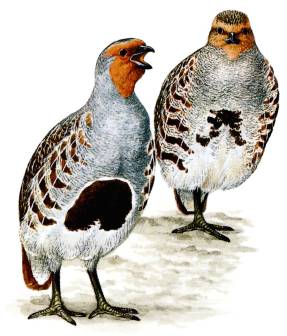 The Grey
Partridge (Perdix perdix) has undergone a dramatic decline in population
over the last 50 years. Figures published by the British Trust for Ornithology
suggest a decline of 78% between 1972 and 1996. Present estimates put the UK
population at around 150,000 pairs. Although the Grey Partridge is still fairly
widespread and can even be locally abundant; their general decline has been
dramatic and it is now one of the most endangered species in the UK. As a
result, the Grey Partridge is the subject of a UK Biodiversity Action Plan which
sets out to halt the decline and ultimately enhance the population and
distribution of one our most important farmland birds.
The Grey
Partridge (Perdix perdix) has undergone a dramatic decline in population
over the last 50 years. Figures published by the British Trust for Ornithology
suggest a decline of 78% between 1972 and 1996. Present estimates put the UK
population at around 150,000 pairs. Although the Grey Partridge is still fairly
widespread and can even be locally abundant; their general decline has been
dramatic and it is now one of the most endangered species in the UK. As a
result, the Grey Partridge is the subject of a UK Biodiversity Action Plan which
sets out to halt the decline and ultimately enhance the population and
distribution of one our most important farmland birds.
Drawing from AA/RSPB Complete Book of
British Birds
The reasons for the Grey’s decline are numerous:
· Increased use of insecticides and herbicides has been detrimental to the insects which provide young chicks with the protein-rich diet that is so vital to their survival in early life.
· This lack of food can threaten the chicks either directly by starvation, or indirectly, as the scarcity of food leads to foraging further from the nest site and thus exposes the young birds to more predation.
· Fewer gamekeepers mean that losses to predation can be very significant.
· Loss of nesting habitat such as hedge bottoms and rough grassland.
As a result of the British Government signing the Rio Convention on Biodiversity in 1992, a large number of UK species and habitats were afforded special protection and became the subject of Biodiversity Action Plans (BAP’s). These Plans set out to halt population declines in certain species and the loss of a variety of unique habitats throughout the country.
In 1997, the Game Conservancy Trust was appointed the lead partner of the action plan for the Grey Partridge. Their objectives were to halt the decline in numbers by 2005, to ensure that the population was above 150,000 pairs by 2010 and to maintain and even extent the range within which Grey’s are currently found. This was to be achieved by a combination of advice on; habitat improvement, land management and pesticide use, backed up by provision of information and monitoring.
As part of our on-going commitment to enhancing biodiversity, Borders FWAG decided to focus on Grey Partridges for it’s series of Whole Farm Conservation Plans in 2001. As such we would like to acknowledge the farmers who have invited us to carry out our plans on their properties, and the Game Conservancy Trust who have provided their latest technical information and guidance.
